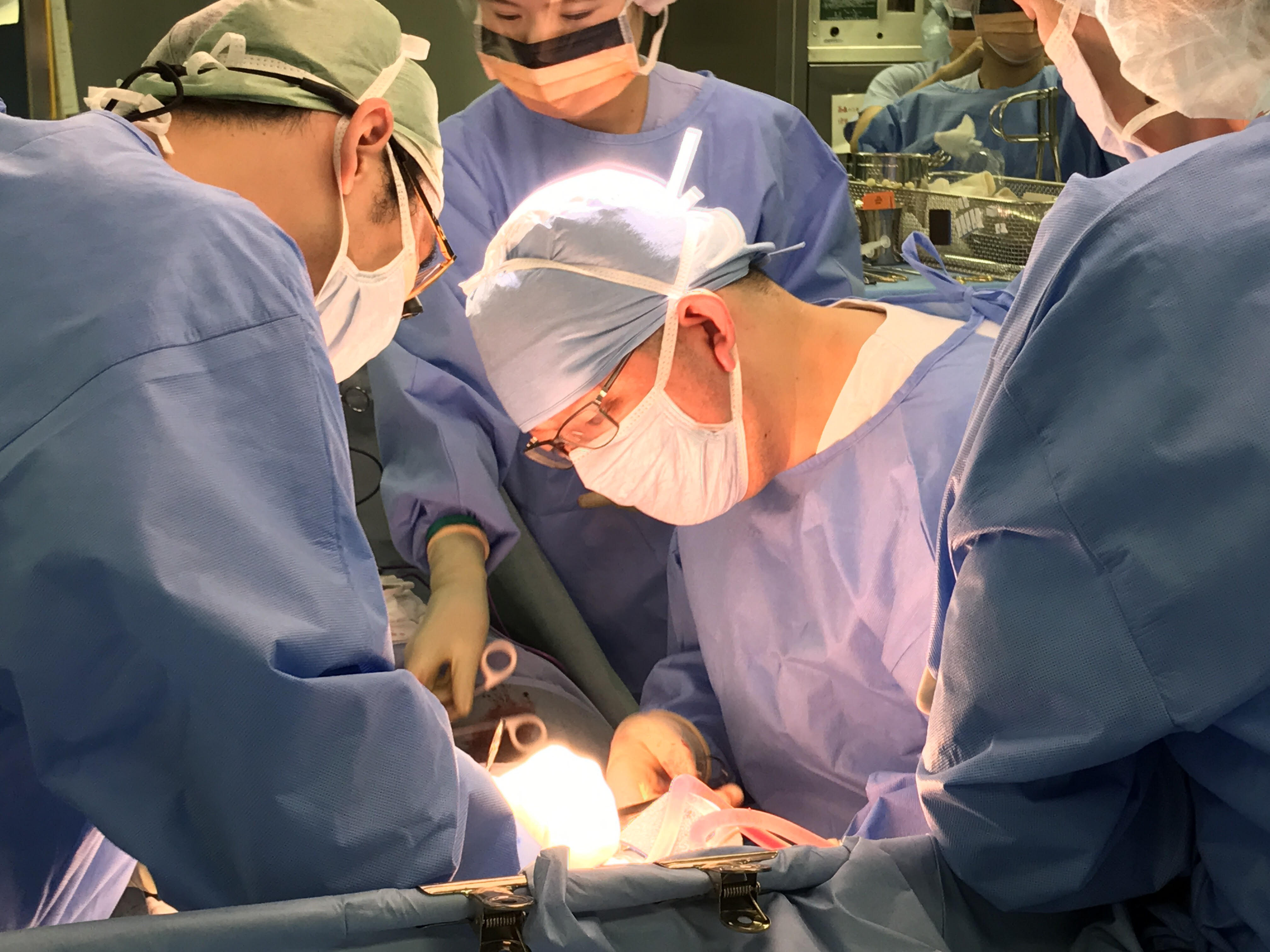Centers & Services
Top > Centers & Services > Clinical Services > Hepato-Biliary-Pancreatic Surgery
Hepato-Biliary-Pancreatic Surgery

Hepato-Biliary-Pancreatic Surgery specializes in the surgical treatment of malignant tumors in the hepatobiliary and pancreatic systems. The department also provides surgical treatment for a wide variety of hepatobiliary and pancreatic diseases including benign diseases such as esophageal varices, cholelithiasis, and anomalous arrangement of the pancreaticobiliary ducts.
Medical services
A team approach is provided in treating patients. Treatment plans are discussed and decided at team conferences based on evidence. The attending physician provides periodic medical consultation to the patient after discharge.
Diagnosis and treatment policy
Surgeons provide surgical treatment for liver cancer and metastatic liver cancer. For patients with portal vein tumor thrombus and multiple metastatic liver cancer who have been declared inoperable elsewhere, doctors at the Hepato-Biliary-Pancreatic Surgery Division carefully investigate the feasibility of surgical resection. Recently, living donor liver transplantation has been included as a treatment options for cirrhotic patients with primary liver cancer.
Specialties
Hepatectomy and pancreatectomy for liver cancer, biliary cancer, and pancreas cancer; liver transplantation
Target diseases
Primary liver cancer, metastatic liver cancer, biliary tract cancer (Klatskin’s tumors, gallbladder cancer, low biliary tract cancer, papillary cancer), pancreatic cancer and other pancreatic tumors, liver abscess, intrahepatic stone, bile duct stone, gallstone cholecystitis, biliary dilatation, anomalous arrangement of the pancreaticobiliary ducts, pancreatitis, portal hypertension esophagogastric varices), etc.
Advanced treatments/ Specialized treatments
Surgical treatment using cryopreserved vein grafts
Navigation system for hepatectomy using 3-dimensional images
Designated institution for Laparoscopic/robot-assisted hepatectomy, pancreatectomy, and pancreaticoduodenectomy
Portal vein embolization: a pre-surgical procedure to enhance the safety of radical hepatectomy
Clinical application of ICG fluorescent images, especially for intraoperative visualization of biliary trees, staining of hepatic segments and detection of micro lesions
Frequently performed tests
Hepatocellular carcinoma
First line treatment is resection if the criteria for hepatectomy are met. For patients with recurrence, re-hepatectomy is performed with the aim of prolonging survival time. Laparoscopic/robotassisted hepatectomy is indicated depending on tumor conditions.
Metastatic liver cancer
Aggressive surgical resection is performed. For patients with recurrence, re-hepatectomy is performed with the aim of complete cure in combination with chemotherapy. Laparoscopic/robotassisted hepatectomy is indicated depending on tumor conditions.
Pancreatic cancer
Pancreaticoduodenectomy or distal pancreatomy is performed according to the site of the tumor. Laparoscopic/robot- assisted approach may be applied to borderline malignancies.
Klatskin’s tumor
Pre-operative percutaneous transhepatic cholangiodrainage (PTCD) and portal vein embolization are performed to enhance safety prior to more radical hepatectomy.
Low biliary tract cancer
Pancreaticoduodenectomy is performed.
Gallbladder cancer
Based on a detailed preoperative diagnosis, rational radical surgery is performed.
Kiyoshi Hasegawa
Departments/Divisions
Hepato-Biliary-Pancreatic Surgery Division, Artificial Organ and Transplantation Division
Titles
M.D. , Ph.D.
Expertise/Specialties
Liver transplantation, Hepato-Biliary-Pancreatic Surgery, Hepatocellular carcinoma, Metastatic liver tumor
Research Interests
Surgical treatments for advanced liver malignant tumors, Fluorescence Guided Surgery, Artificial blood vessel
Languages
Japanese / English
Numbers of major operations and treatments performed
| Name of operation/treatment | Number |
|---|
| 1 | Hepatectomy (including hepatocellular cancer: 66; metastatic hepatic cancer: 74; and others: 34) | 177 |
| 2 | Donor hepatectomy for liver transplantation | 14 |
| 3 | Pancreaticoduodenectomy | 60 |
| 4 | Distal pancreatectomy | 35 |
| 5 | Laparoscopic surgeries (including hepatectomy: 12; pancreatectomy 5:cholecystectomy: 78) | 102 |
(2015)
Areas of expertise, treatment and examination methods
Diseases
- Hepatocellular and cholangiocellular cancer
- Metastatic hepatic cancer (such as colon cancer)
- Pancreatic cancer and pancreatic neuroendocrine tumors
- Hepatic portal cholangiocarcinoma
- Carcinoma of the middle and lower thirds of the bile duct
- Gallbladder cancer
- Malfusion of the pancreaticobiliary duct
- Portal hypertension (such as esophageal and gastric varices and hypersplenism)
Treatment methods
Resection is considered as first-line treatment, depending on the hepatic function and tumor condition. In metastatic hepatic cancer, technically resectable metastatic lesions are removed in principle, without setting upper limits. Recurrent lesions are actively re-resected for cure. While increasing the safety level by performing preoperative biliary drainage, portal embolization, and 3-D image analysis (as image-based navigation for hepatectomy), more curative techniques, such as extended hepatectomy and hepatopancreatoduodenectomy, may be adopted in some cases.
Examination methods
CT scans; abdominal ultrasound; angiography; endoscopic ultrasound (EUS): Primovist contrast-enhanced MRI (EOB-MRI); magnetic resonance cholangiopancreatography (MRCP); endoscopic retrograde cholangio-pancreatography (ERCP); and 3-D image analysis (image-based navigation for hepatectomy);diagnosis using the ICG fluorescence method; navigation surgery

